In a world full of uncertainties, being prepared is more than just a smart choice; it’s a way of life that brings peace of mind and security. Whether you’re concerned about natural disasters, economic instability, or everyday emergencies, having a solid preparedness plan is crucial. This comprehensive guide will help you get started on your journey to becoming self-reliant. We’ll cover everything from understanding the basics of preparedness, assessing your specific needs, and building your essential supplies, to developing a solid plan, honing vital skills, and staying informed. With this guide, you’ll be equipped with the knowledge and tools to face any challenge with confidence and resilience. Plus, we’ve included a handy checklist available as a free download to help you stay organized and ensure you don’t miss any critical steps.
1. Understanding Preparedness
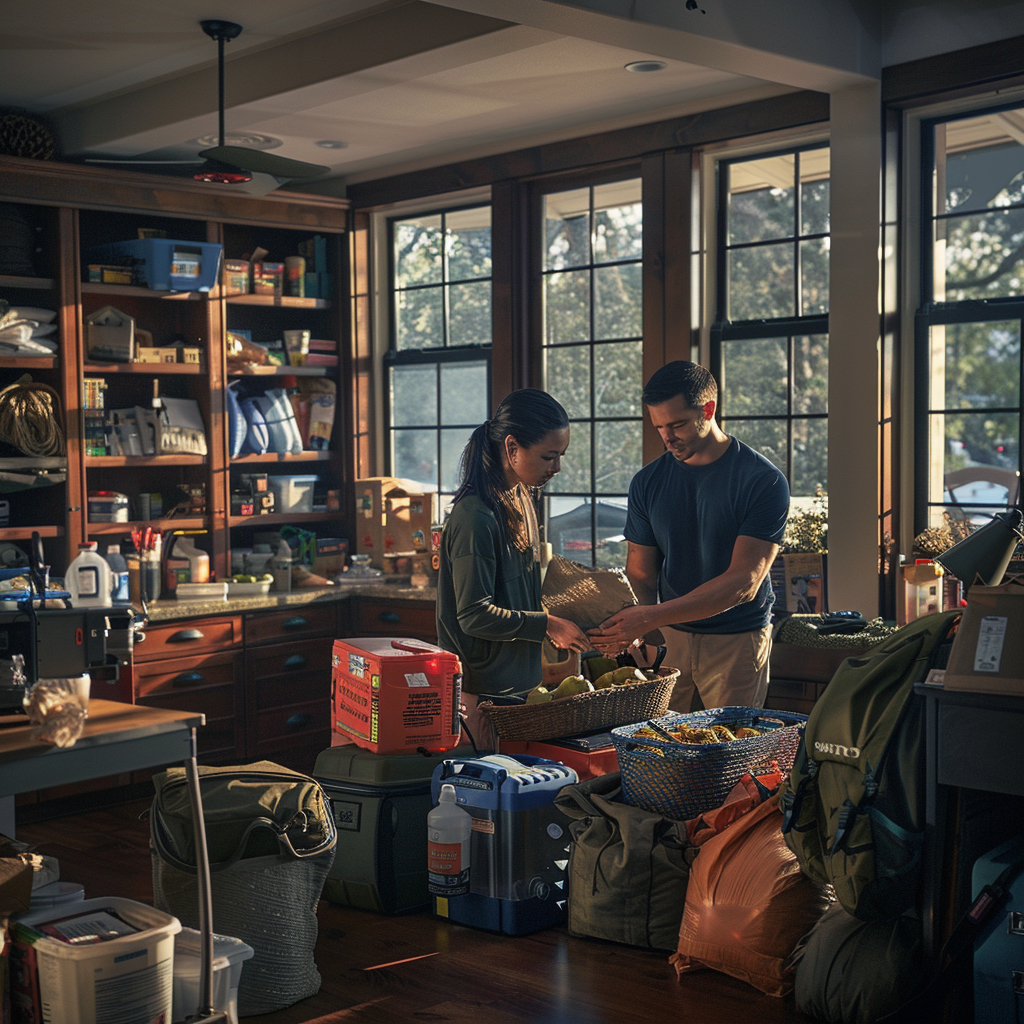
What is Preparedness?
Preparedness is the process of planning and implementing measures to be ready for emergencies and unexpected events. It involves being proactive in acquiring the knowledge, skills, and resources needed to protect yourself and your loved ones during times of crisis. Preparedness isn’t just about having a stockpile of supplies; it’s about developing a comprehensive plan that addresses various scenarios and ensures you can respond effectively to any situation. From natural disasters like earthquakes and hurricanes to man-made events such as power outages and economic disruptions, being prepared means you’re equipped to handle whatever comes your way.
The concept of preparedness has evolved over the years, becoming more holistic and inclusive of various aspects of life. It’s not just about surviving but thriving in adverse conditions. This involves mental, physical, and emotional readiness, as well as the practical aspects of having the right tools and supplies. By understanding what preparedness entails, you can start building a robust plan that covers all bases, ensuring you’re not caught off guard when disaster strikes.
Preparedness also fosters a sense of empowerment and control in an unpredictable world. Knowing that you have taken steps to safeguard your family and home provides peace of mind and reduces anxiety. It encourages a proactive mindset, where you actively seek out information, resources, and training to continually improve your readiness. This guide will walk you through the fundamental concepts of preparedness, helping you develop a solid foundation on which to build your emergency plans.
Why is it Important?
The importance of preparedness cannot be overstated. In times of crisis, those who have prepared are better equipped to handle the challenges and recover more quickly. Preparedness minimizes the impact of emergencies by ensuring that you have the necessary resources and plans in place to respond effectively. It can mean the difference between safety and danger, survival and catastrophe. By being prepared, you are taking responsibility for your well-being and that of your family, reducing your reliance on external assistance, which may be delayed or unavailable during widespread emergencies.
Preparedness is also a crucial component of community resilience. When individuals and families are prepared, the entire community benefits. Resources can be allocated more efficiently, and emergency services can focus on those who are most in need. Preparedness reduces the strain on public services and enhances the overall recovery process. By fostering a culture of preparedness within your community, you contribute to a more resilient and robust society capable of withstanding and bouncing back from adverse events.
Moreover, preparedness is not just about responding to emergencies but also about preventing them. Through preparedness activities such as maintaining your home, practicing safe behaviors, and staying informed about potential threats, you can prevent minor issues from escalating into major disasters. This proactive approach saves lives, reduces injuries, and mitigates property damage. As you delve into the subsequent sections of this guide, you will learn practical steps to enhance your preparedness and ensure you are ready for any eventuality.
Preparedness vs. Panic
One of the key distinctions to understand in the realm of emergency readiness is the difference between preparedness and panic. Preparedness is a calm, calculated approach to anticipating and mitigating risks, while panic is a reactionary state that often leads to poor decision-making and heightened danger. Preparedness involves thoughtful planning, gathering essential supplies, and practicing emergency procedures to ensure a measured and effective response when needed.
Panic, on the other hand, can be paralyzing. It stems from a lack of preparation and an overwhelming sense of fear and uncertainty. When people panic, they tend to make hasty decisions, overlook critical steps, and exacerbate the situation. By fostering a culture of preparedness, you can mitigate the risk of panic. Knowing that you have a plan in place and the necessary resources at your disposal can provide the confidence needed to stay calm and focused during emergencies.
Preparedness also means staying informed and aware of your surroundings and potential threats. This awareness allows you to act quickly and decisively, reducing the likelihood of panic. By practicing emergency drills and familiarizing yourself with your preparedness plan, you reinforce your ability to remain composed under pressure. As you continue through this guide, you’ll find strategies to enhance your preparedness, ensuring that you can face emergencies with confidence and clarity, rather than succumbing to panic.
2. Assessing Your Needs
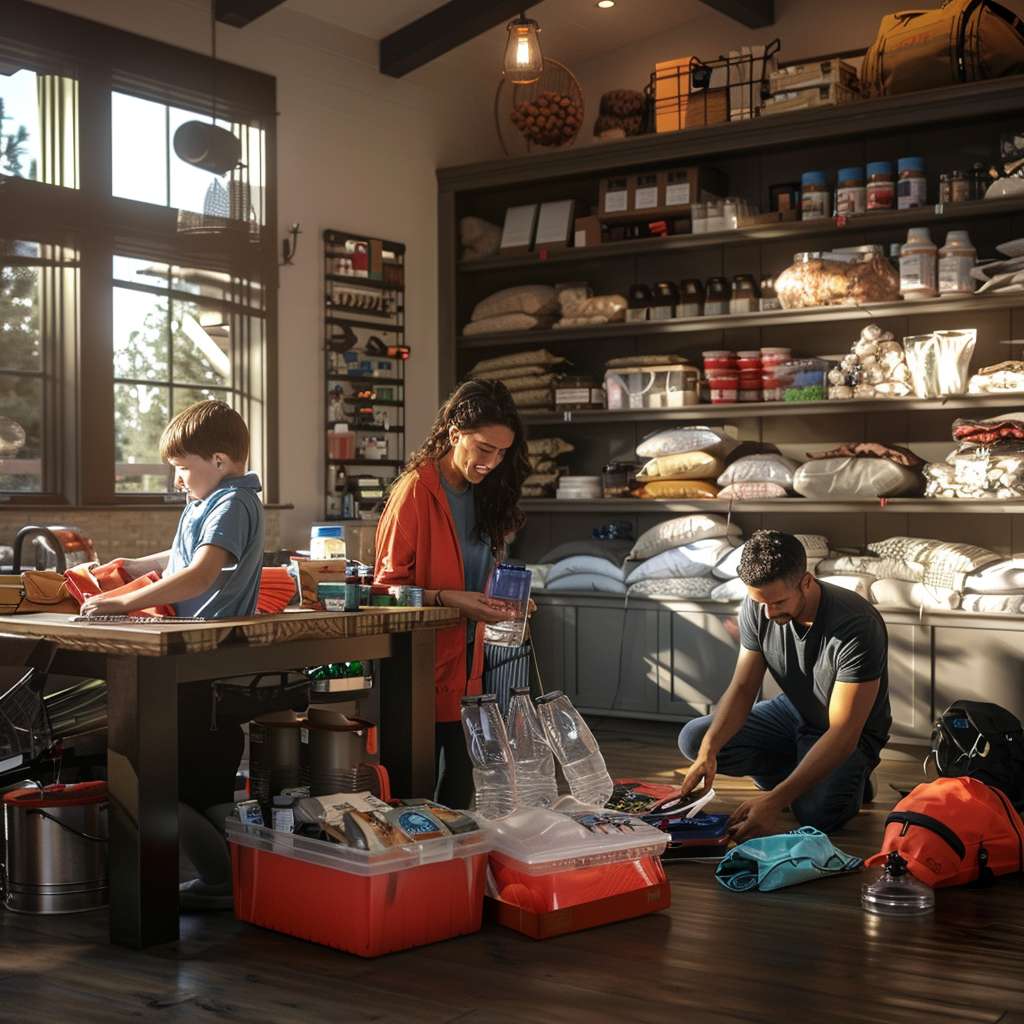
Personal and Family Needs
Understanding the unique needs of yourself and your family is the first step in creating a robust preparedness plan. Each household has different requirements based on the number of members, ages, health conditions, and any special needs. Begin by conducting a thorough assessment of what each individual in your household requires daily, including medications, dietary needs, mobility aids, and any specific medical equipment. This detailed evaluation will help you compile a comprehensive list of supplies necessary to sustain your family during an emergency.
Consider the specific needs of vulnerable family members, such as infants, elderly relatives, or those with chronic illnesses. For instance, if someone in your household relies on daily medication, ensure you have an adequate supply on hand and a plan for keeping it stored properly during a power outage. Similarly, infants may require formula, diapers, and other baby care essentials. By addressing these personal and specific family needs, you can ensure that everyone in your household is adequately prepared and supported in the event of a disaster.
Communication is also a crucial aspect of meeting personal and family needs. Establish a family communication plan that includes designated meeting spots, emergency contact numbers, and a method for checking in with each other. Make sure everyone in the household understands the plan and knows what to do in various scenarios. Regularly reviewing and practicing this plan will help reinforce the steps and ensure that everyone feels confident and prepared to act when needed.
Environmental Factors
Environmental factors play a significant role in shaping your preparedness strategy. The geographical location of your home, climate conditions, and potential natural disasters all influence the types of emergencies you may encounter. Begin by identifying the specific environmental risks in your area, such as hurricanes, earthquakes, floods, wildfires, or extreme temperatures. Understanding these risks will guide you in tailoring your preparedness plan to address the most likely scenarios.
For example, if you live in a hurricane-prone region, focus on securing your home with storm shutters, reinforcing roofs and windows, and having an evacuation plan in place. Conversely, if you reside in an earthquake zone, prioritize securing heavy furniture, creating an earthquake kit, and knowing safe spots within your home to take cover during tremors. Each environmental factor requires specific preparations to minimize risks and enhance your resilience.
Climate conditions also affect your preparedness plan. Consider the seasonal variations in your area and how they impact your supply needs. In colder climates, ensure you have adequate heating sources, warm clothing, and insulated shelters. In hotter regions, prioritize hydration, sun protection, and cooling methods. By factoring in these environmental considerations, you can develop a comprehensive preparedness plan that addresses the unique challenges posed by your surroundings, ensuring you are ready for any situation.
Health Considerations
Health considerations are paramount in any preparedness plan. Evaluate the health status of each household member and identify any specific medical needs or vulnerabilities. This includes chronic conditions, allergies, disabilities, and mental health concerns. Having a clear understanding of these health factors will help you prepare adequately and ensure that everyone receives the care they need during an emergency.
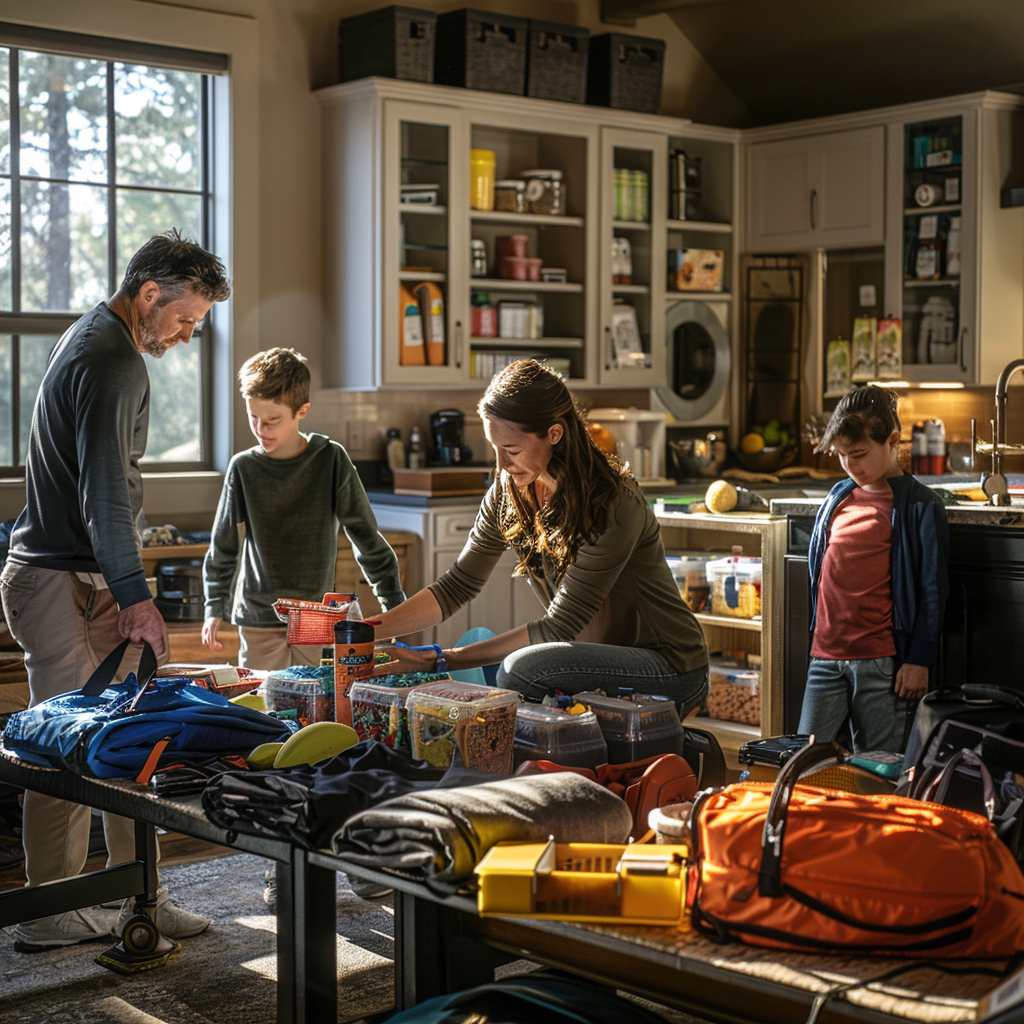
Compile a detailed medical history for each family member, including current medications, dosages, allergies, and healthcare provider information. Store this information in a secure but easily accessible location, such as a waterproof and fireproof container. Additionally, ensure you have a well-stocked first aid kit that includes supplies tailored to your family’s specific needs, such as asthma inhalers, insulin, or EpiPens. Regularly check the expiration dates of medications and medical supplies, and rotate them as needed to keep your stock current.
Mental health is another crucial aspect of preparedness. Emergencies can be highly stressful and traumatic, impacting mental well-being. Develop strategies to support mental health during crises, such as having comfort items on hand, maintaining routines as much as possible, and fostering open communication. Encourage family members to express their feelings and provide reassurance. By addressing both physical and mental health considerations, you create a more comprehensive and effective preparedness plan that ensures the well-being of everyone in your household during emergencies.
3. Building Your Basic Supplies

Beans (Food & Water)
Food and water are the cornerstones of any preparedness plan. Ensuring you have a reliable supply of both is crucial for survival during emergencies. Start by stocking up on non-perishable food items that have a long shelf life, such as canned goods, dried beans, rice, pasta, and freeze-dried meals. Aim to have at least a three-day supply per person, but ideally, you should aim for a week’s supply, with the final goal being three months or more. Remember to include food items that cater to specific dietary needs within your household.
Water is even more critical than food. The absolute minimum is to store one gallon of water per person per day, covering drinking, cooking, and sanitation needs. This means for a family of four, you would need at least 12 gallons for a three-day period. Water can be stored in commercially bottled containers, or you can use food-grade water storage containers. It’s also wise to invest in water purification methods, such as water filters, purification tablets, or a portable water purification system, to ensure a continuous supply of safe drinking water.
Proper storage is essential to maintaining the quality and safety of your food and water supplies. Store food in a cool, dry place, away from direct sunlight and pests. Rotate your food stock regularly to keep it fresh, and check expiration dates periodically. For water, keep storage containers sealed and in a dark, cool area to prevent contamination. Regularly replace stored water every six months if not using commercially bottled water. By prioritizing food and water in your preparedness plan, you ensure that your family can stay nourished and hydrated during any emergency.
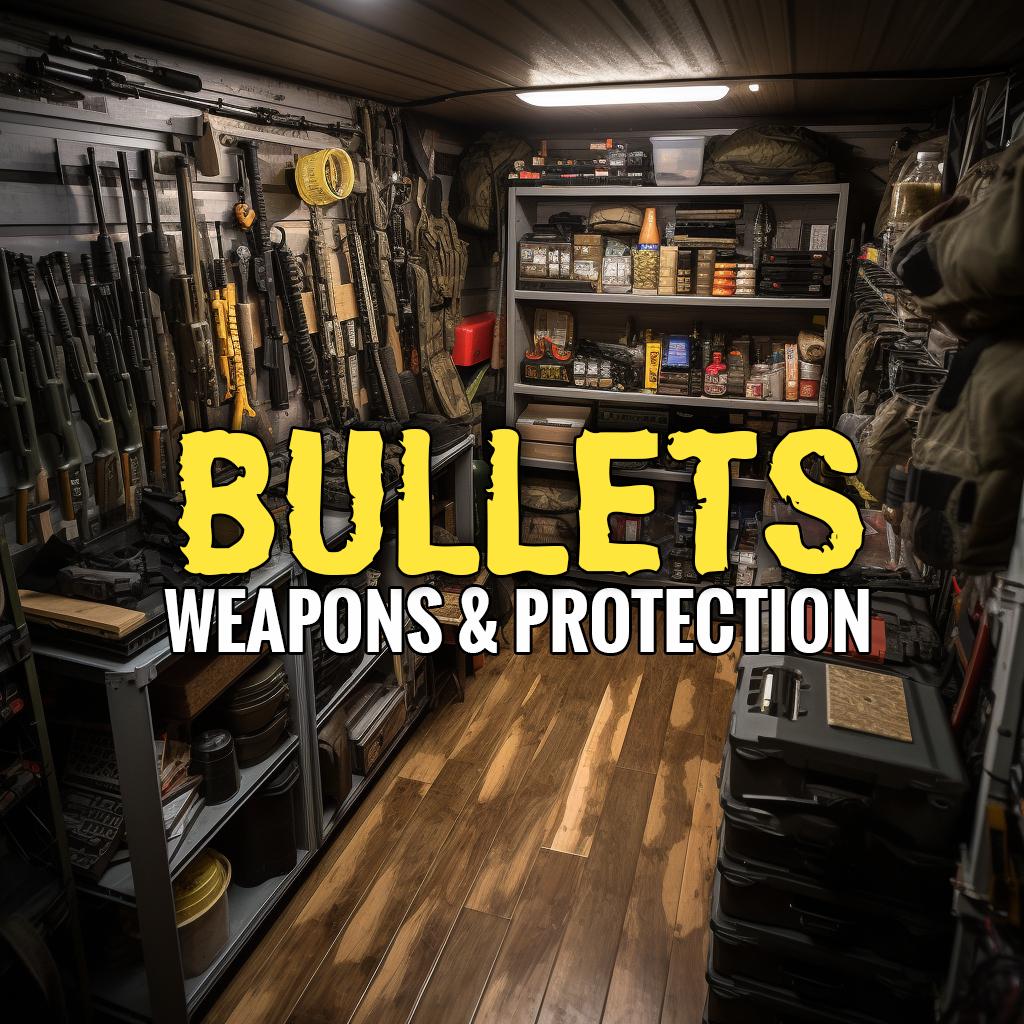
Bullets (Weapons & Protection)
Personal protection is a vital component of preparedness, especially in scenarios where law and order may be compromised. Having the means to defend yourself and your family can provide peace of mind and security. Firearms are a common choice for personal protection, but it’s essential to choose the right type of firearm and understand how to use it safely and responsibly. Handguns, shotguns, and rifles each have their own advantages and are suitable for different situations.
In addition to firearms, consider non-lethal self-defense tools such as pepper spray, stun guns, and personal alarms. These can be effective in deterring potential threats without the risks associated with firearms. Whichever method of protection you choose, it’s crucial to receive proper training. Enroll in self-defense classes or firearm safety courses to build confidence and competence. Regular practice is also essential to maintain proficiency.
Beyond personal protection, think about the security of your home. Reinforce doors and windows, install security cameras and alarm systems, and consider keeping a guard dog. Creating a safe room within your home can provide a secure space to retreat to in case of an intruder. By addressing both personal and home security, you create multiple layers of protection, enhancing your overall preparedness.

Blankets (Equipment)
Having the right equipment is essential for surviving and thriving in various emergency scenarios. This category includes items like camping gear, shelter solutions, and tools that can make a significant difference in your ability to handle crises. Start with the basics: a good-quality tent or emergency shelter, sleeping bags, and blankets to keep you warm and protected from the elements. Choose gear that is durable, weather-resistant, and easy to set up.
Fire-making tools are also critical. Matches, lighters, fire starters, and waterproof tinder should be part of your kit. Being able to start a fire can provide warmth, cooking capabilities, and a means to signal for help. Additionally, ensure you have a reliable source of light, such as flashlights, headlamps, and lanterns, along with extra batteries, solar, or a hand-crank generator. These tools are indispensable in power outages and low-light situations.
Multi-tools and survival knives are invaluable for a wide range of tasks, from preparing food to building shelters. Invest in a quality multi-tool that includes pliers, screwdrivers, a can opener, and other useful features. Navigation tools like maps, compasses, and GPS devices are also essential, especially if you need to evacuate or find your way in unfamiliar terrain. By equipping yourself with the right gear, you can handle emergencies more effectively and increase your chances of staying safe and comfortable.
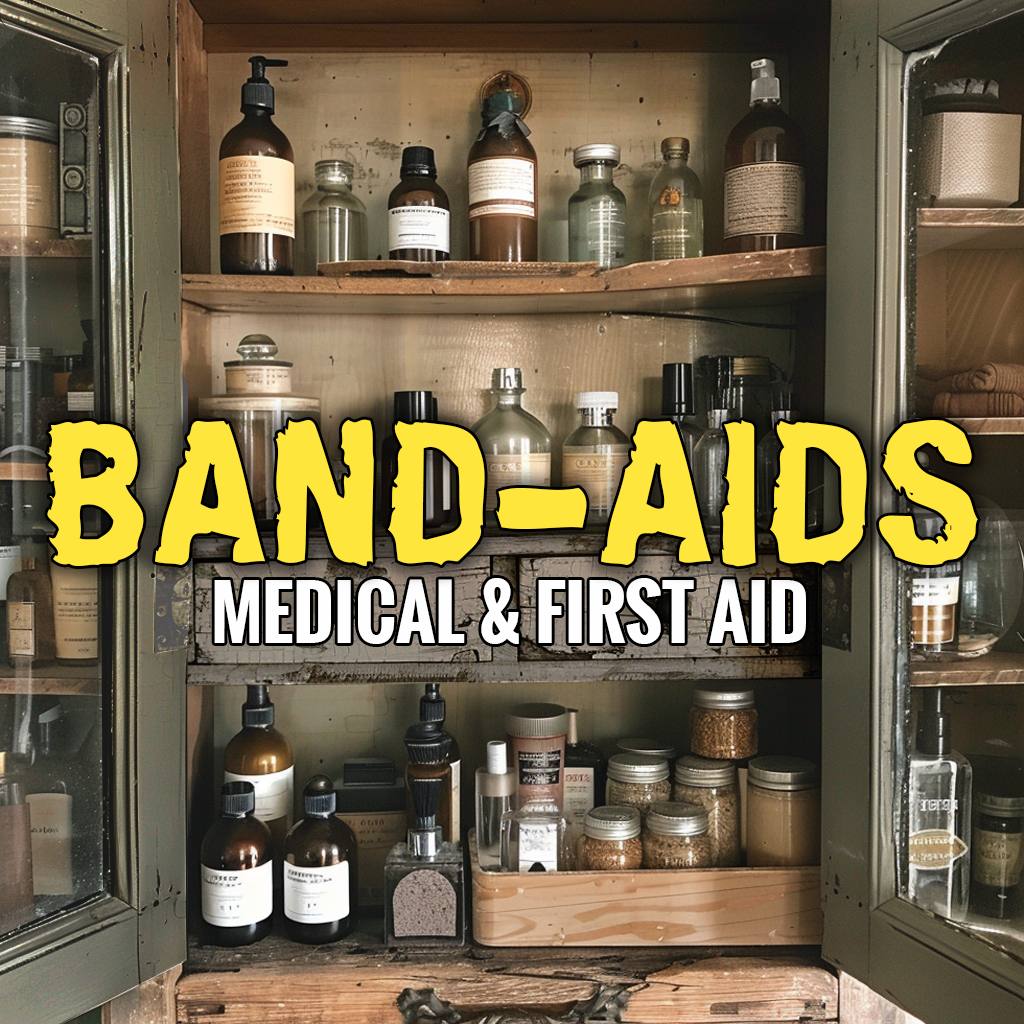
Band-Aids (Medical & First Aid)
When it comes to preparedness, having a well-stocked first aid kit is non-negotiable. Medical emergencies can occur without warning, and being equipped to handle minor injuries and provide immediate care can make a significant difference. Start by assembling a comprehensive first aid kit that includes essentials such as bandages, gauze, adhesive tape, antiseptic wipes, and antibiotic ointment. Make sure to have a variety of bandage sizes and types to address different injuries, from small cuts to larger wounds.
In addition to basic first aid supplies, include items that cater to specific medical needs within your household. This might involve adding over-the-counter medications like pain relievers, antihistamines, and anti-inflammatory drugs. If anyone in your family has a prescription medication, ensure you have an ample supply stored safely. Remember to rotate medications to keep them within their expiration dates. A first aid manual or guidebook is also a valuable addition, providing instructions on how to treat various injuries and medical conditions.
First aid training is just as important as having the right supplies. Enroll in a basic first aid and CPR course to gain the skills needed to handle medical emergencies effectively. Understanding how to assess and respond to injuries can boost your confidence and ability to act swiftly in critical situations. Moreover, consider expanding your knowledge to include advanced first aid techniques, such as wound closure methods, splinting broken bones, and managing shock. Regular practice and refresher courses can keep your skills sharp and ensure you’re ready to provide essential care when it’s needed most.
Finally, think about the storage and accessibility of your first aid kit. Place kits in strategic locations around your home, such as the kitchen, bathroom, and vehicle. Ensure everyone in your household knows where the kits are stored and how to use the supplies. In addition to home kits, consider creating smaller, portable kits for outdoor activities, travel, and work. By prioritizing first aid in your preparedness plan, you can address injuries promptly and effectively, contributing to the overall safety and well-being of your family during emergencies.
4. Developing a Plan
Emergency Contacts
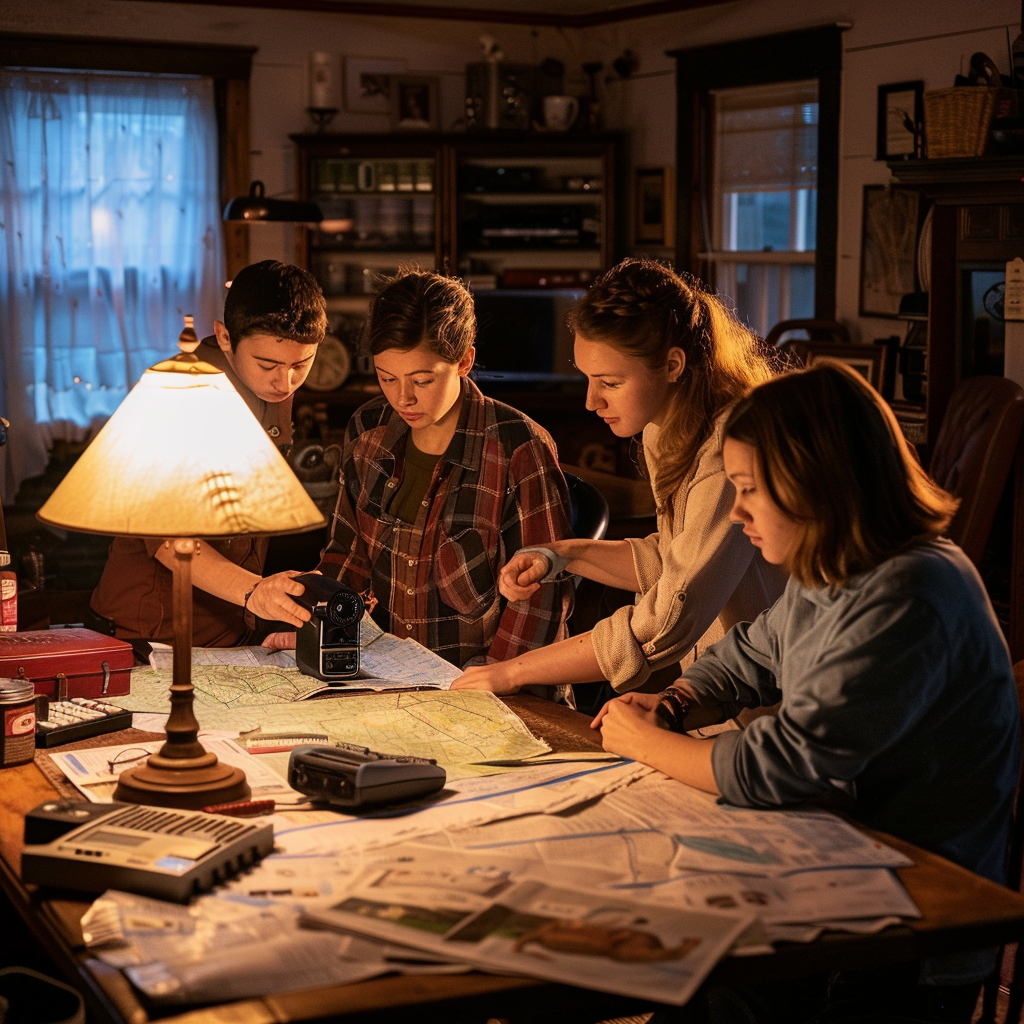
Establishing a comprehensive list of emergency contacts is a vital component of your preparedness plan. This list should include phone numbers for local emergency services, hospitals, and utility companies, as well as contacts for family members, neighbors, and friends who can provide assistance in a crisis. Make sure to include alternative contact methods, such as email addresses and social media handles, in case traditional phone lines are down. It’s essential to keep this list updated and readily accessible to all household members.
In addition to local contacts, consider including national and regional emergency hotlines that can provide guidance and support during widespread disasters. It’s also helpful to have contact information for your insurance company and healthcare providers. Print out multiple copies of your emergency contact list and place them in strategic locations around your home, such as near phones, in your emergency kit, and in each vehicle. Digital copies stored on your phone and cloud services can also ensure you have access even if physical copies are lost or damaged.
Communication during an emergency can be challenging, so it’s crucial to establish a family communication plan. Designate a primary and secondary meeting point where family members can gather if separated. Choose an out-of-town contact person whom everyone can reach out to and relay information. Practice this plan regularly to ensure everyone knows what to do and where to go. By having a well-organized emergency contact list and communication plan, you can reduce confusion and ensure timely support during critical situations.
Evacuation Routes
Planning and practicing evacuation routes are essential steps in your preparedness strategy. Identify multiple exit routes from your home and neighborhood to ensure you can leave safely in various scenarios. Consider potential obstacles such as blocked roads or damaged infrastructure and plan alternative routes accordingly. Familiarize yourself with local evacuation routes designated by emergency management authorities and incorporate them into your plan.
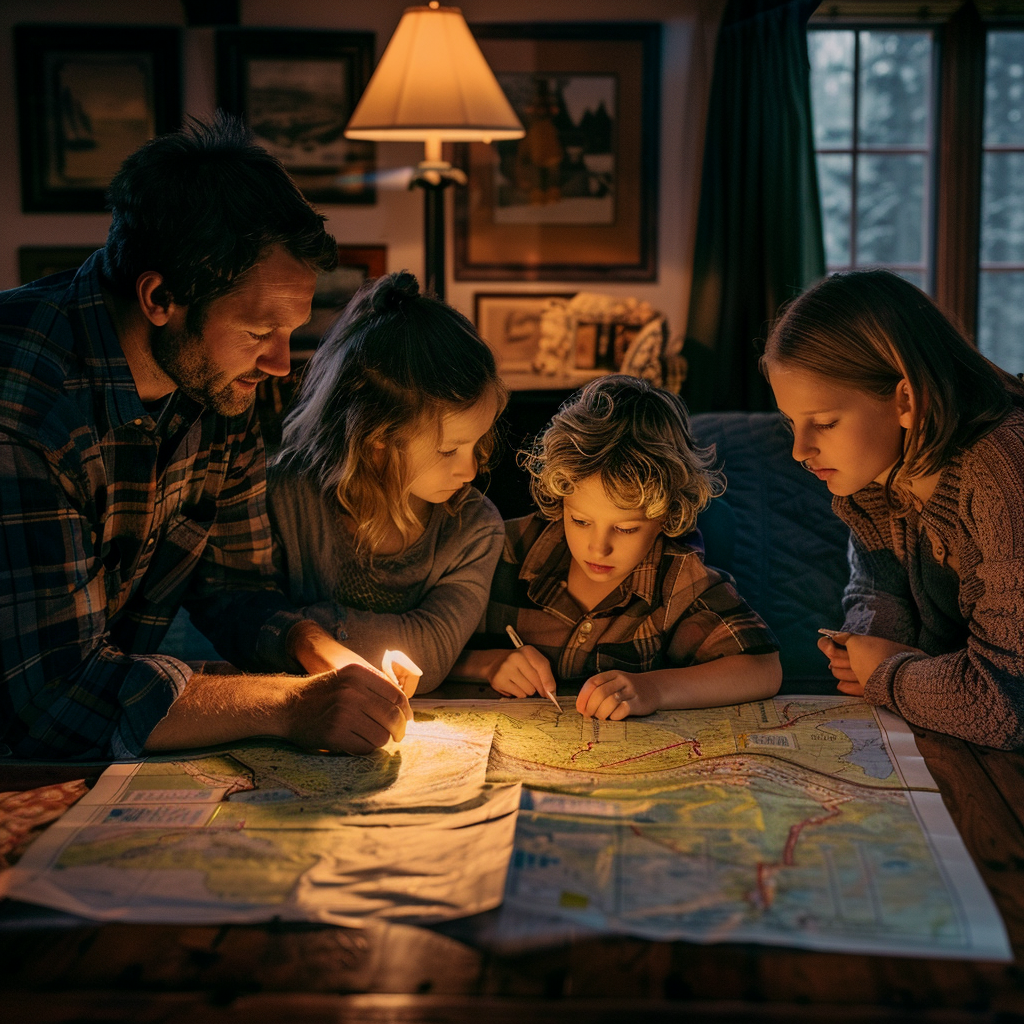
In addition to planning routes, it’s crucial to prepare an evacuation kit, also known as a “go-bag,” that includes essential items you may need if you must leave your home quickly. This kit should contain supplies like food, water, clothing, important documents, medications, and basic first aid items. Keep your go-bag in an easily accessible location and make sure all family members know where it is stored. Regularly check and update the contents of your go-bag to ensure everything is current and in good condition.
Practice your evacuation plan with all household members, including children and pets. Conduct regular drills to ensure everyone knows the evacuation routes and procedures. Teach family members how to safely exit the home, where to meet, and how to communicate during an evacuation. Familiarity with the plan can reduce panic and increase efficiency during an actual emergency. By having well-practiced evacuation routes and an equipped go-bag, you can ensure a swift and organized departure from your home when necessary.
Communication Types
In an emergency, staying connected with family members and coordinating efforts can be a lifeline. Different communication types offer various strengths and can help ensure that you remain in contact even when traditional phone lines are down. Here’s a look at some essential communication methods you should consider incorporating into your preparedness plan.
GMRS (General Mobile Radio Service)
GMRS radios are robust, high-powered devices ideal for long-distance communication. They require a license to operate in the United States but provide a reliable means of communication over several miles, making them perfect for keeping in touch with family members during emergencies. GMRS radios are excellent for coordinating with neighbors or other members of your preparedness community, ensuring everyone is on the same page.
FRS (Family Radio Service)
FRS radios are similar to GMRS but operate at lower power levels and do not require a license. They are perfect for short-range communication, typically within a couple of miles. FRS radios are user-friendly and ideal for families to stay in touch within a localized area, such as a neighborhood or small community. They are also great for use during outdoor activities or short-term evacuations.
Ham Radio
Ham radios offer the most extensive range and versatility among these communication types. They require a license to operate, but the effort is worthwhile due to their ability to communicate over vast distances and even connect with repeaters to extend their range further. Ham radio operators can communicate locally, regionally, and internationally, making them invaluable during widespread emergencies where traditional communication networks are compromised. They also provide access to a community of experienced operators who can offer assistance and information during crises.
Text Messages
Text messaging is a simple yet effective communication method that often works even when voice calls cannot go through. Texts require minimal bandwidth and can get through congested networks more easily than calls. Encourage family members to use text messages to check in and share updates during emergencies.
Emails
Emails are another reliable form of communication, particularly for non-urgent messages and sharing detailed information. While dependent on internet connectivity, emails can be accessed from various devices, including smartphones, tablets, and computers. Ensure all family members have access to a shared email account or know each other’s email addresses for updates and information exchange.
Social Media
Social media platforms like Facebook, Twitter, and Instagram can be valuable tools for staying informed and connected during emergencies. Many local government agencies and emergency services use social media to disseminate information quickly. Family members can also use these platforms to check in and share updates with a broader network. However, always verify information from trusted sources to avoid misinformation.
Weather Radios
While not for two-way communication, weather radios are essential for receiving real-time updates on weather conditions and emergency alerts. NOAA weather radios can broadcast alerts from the National Weather Service, providing critical information during severe weather events and other emergencies. Keep a battery-powered or hand-crank weather radio as part of your emergency kit to stay informed.
By incorporating a mix of these communication types into your emergency preparedness plan, you can ensure that you have multiple avenues to stay connected and informed during crises. Each method has its strengths and ideal use cases, so having a diverse communication strategy will enhance your ability to coordinate and respond effectively when it matters most.
5. Building Skills
First Aid Training
First aid training is an indispensable part of any preparedness plan. Understanding how to provide immediate care in the event of an injury or medical emergency can save lives and prevent minor issues from becoming major problems. Enroll in a certified first aid and CPR course offered by organizations such as the American Red Cross or local health departments. These courses teach essential skills like treating wounds, performing CPR, managing choking incidents, and recognizing the signs of more severe conditions like heart attacks or strokes.
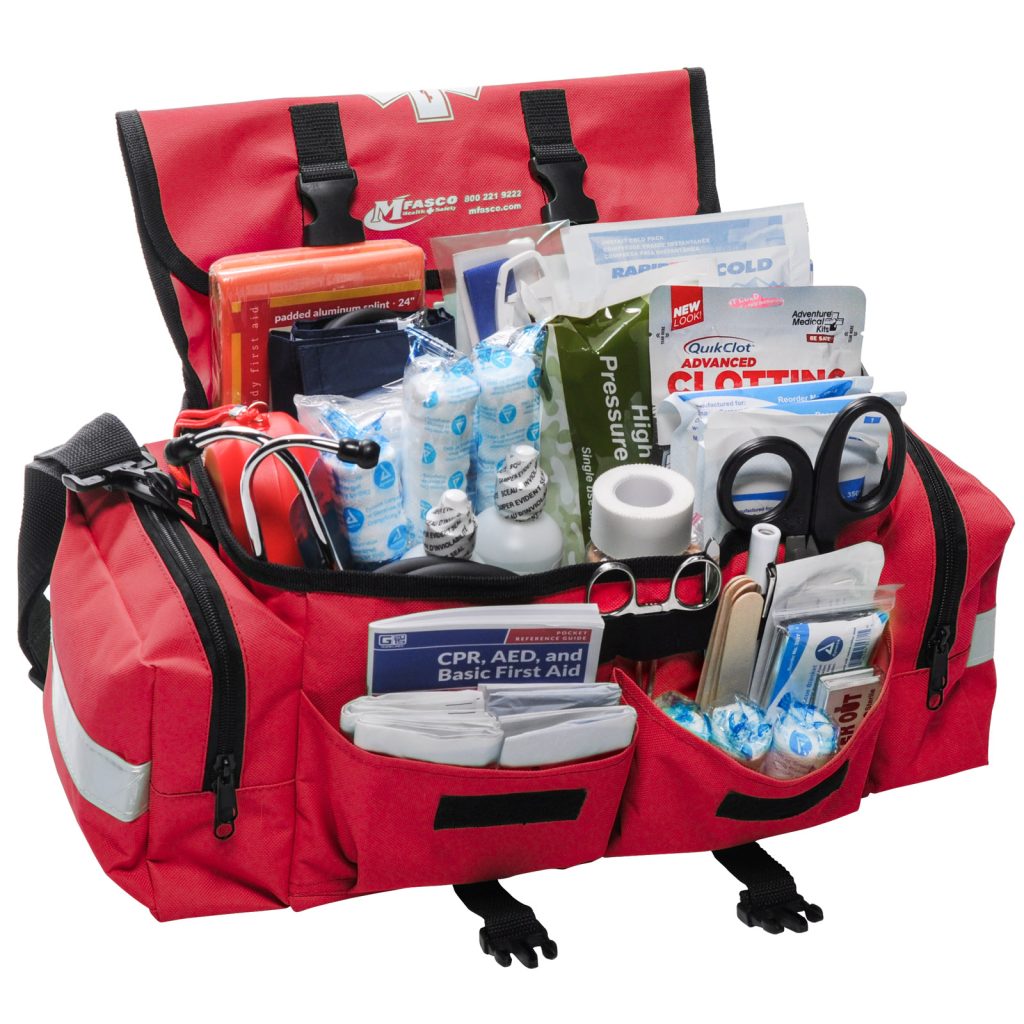
Practical, hands-on training is vital for building confidence and competence in first aid. During these courses, you’ll practice techniques under the guidance of experienced instructors, ensuring you can perform them correctly in real-life situations. Make sure all family members, including older children, participate in the training to ensure everyone is capable of providing aid. Additionally, some courses offer advanced first aid training, which can be beneficial for those looking to deepen their knowledge and skills.
Once you’ve completed your training, keep your skills sharp through regular practice and refresher courses. First aid techniques can be forgotten over time, so periodic retraining is crucial. Update your first aid kit regularly to ensure you have all necessary supplies and that they are within their expiration dates. By prioritizing first aid training, you empower yourself and your family to respond effectively to medical emergencies, significantly enhancing your overall preparedness.
Survival Skills

Building a strong foundation of survival skills is crucial for navigating a variety of emergency situations. These skills can include fire-making, shelter-building, navigation, and food and water procurement. Start by learning how to create a fire using different methods, such as matches, lighters, and fire starters. Fire is essential for warmth, cooking, and signaling for help. Practice building fires in different conditions to ensure you can do so reliably when needed. Building a fire also satisfies a primal mental aspect, providing peace of mind and a sense of empowerment.
Shelter-building is another critical skill. Learn how to construct temporary shelters using natural materials or emergency supplies like tarps and paracord. Your shelter should protect you from the elements, provide warmth, and offer a degree of security. Additionally, familiarize yourself with basic navigation techniques. This includes reading maps, using a compass, and understanding natural navigation cues. These skills can be life-saving if you find yourself disoriented or need to travel through unfamiliar terrain.
Food and water procurement skills are also essential. Learn how to identify edible plants, hunt small game, and fish if necessary. Understanding water purification techniques is crucial for ensuring you have access to safe drinking water. This can include using water filters, boiling water, or utilizing purification tablets. By mastering these survival skills, you increase your ability to remain self-sufficient and resilient in a wide range of emergency scenarios.
Self-Defense
Self-defense skills are a vital component of personal safety and preparedness. Understanding how to protect yourself and your loved ones from potential threats can provide peace of mind and enhance your overall security. Start by enrolling in self-defense classes that teach practical techniques for responding to various types of threats. These classes often cover strategies for avoiding danger, de-escalating conflicts, and physically defending yourself if necessary.

In addition to physical self-defense techniques, consider learning about situational awareness. This involves being aware of your surroundings, recognizing potential threats, and understanding how to respond proactively. Situational awareness can help you avoid dangerous situations before they escalate, reducing the likelihood of needing to use physical self-defense. Practice these skills regularly to keep them sharp and instinctive.
Firearm training is another aspect of self-defense to consider. If you choose to include firearms in your preparedness plan, ensure you receive proper training on safe handling, shooting, and storage. Join a local shooting range or club where you can practice regularly and receive guidance from experienced instructors. Additionally, familiarize yourself with local laws and regulations regarding firearm ownership and use. By building a comprehensive set of self-defense skills, you enhance your ability to protect yourself and your family in a variety of situations, contributing to a well-rounded preparedness plan.
6. Staying Informed
Resources and Tools
Staying informed is a critical aspect of preparedness, ensuring you have the knowledge and tools needed to respond effectively to emergencies. Begin by identifying reliable sources of information, such as government agencies, emergency management organizations, and reputable preparedness websites. Ready.gov, FEMA, and the CDC provide valuable information on disaster preparedness, response strategies, and safety guidelines. Bookmark these sites and check them regularly for updates and new resources.

Books and manuals are also excellent resources for building your knowledge base. Consider adding titles like “The Survival Medicine Handbook” by Dr. Joseph Alton and “The Prepper’s Blueprint” by Tess Pennington to your library. These books cover a wide range of topics, from medical care and food storage to self-defense and survival skills. Additionally, mobile apps such as the American Red Cross Emergency app and FEMA’s app offer real-time alerts, safety tips, and step-by-step guides to help you stay prepared on the go.
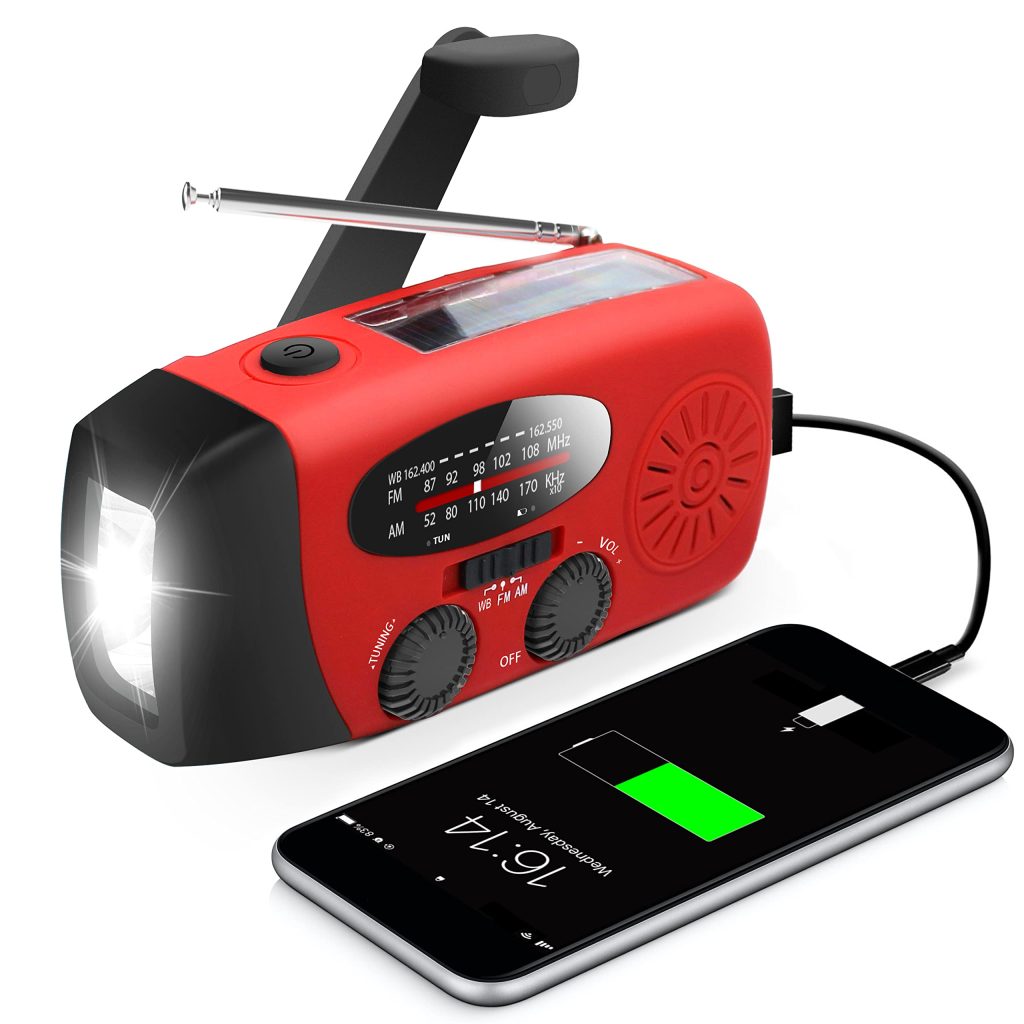
Equip yourself with tools that enhance your ability to stay informed during emergencies. A reliable weather radio, for example, can provide critical updates on severe weather and other emergencies, even when power and internet services are down. Consider investing in a hand-crank or solar-powered radio to ensure you can receive information regardless of the situation. By leveraging these resources and tools, you can make informed decisions during emergencies.
Community Involvement
Engaging with your community is a powerful way to enhance your preparedness efforts. Joining local preparedness groups or online forums can provide valuable opportunities to share knowledge, resources, and support with like-minded individuals. Community groups often organize training sessions, workshops, and drills that can help you build essential skills and stay updated on best practices. Participating in these activities fosters a sense of camaraderie and collective resilience.
Volunteering with local emergency services or organizations such as the Red Cross can also be incredibly beneficial. These experiences provide firsthand insight into emergency response operations and allow you to contribute to your community’s preparedness efforts. Additionally, you’ll gain practical skills and training that can enhance your personal preparedness plan. Volunteering is a rewarding way to give back to your community while building your own resilience.
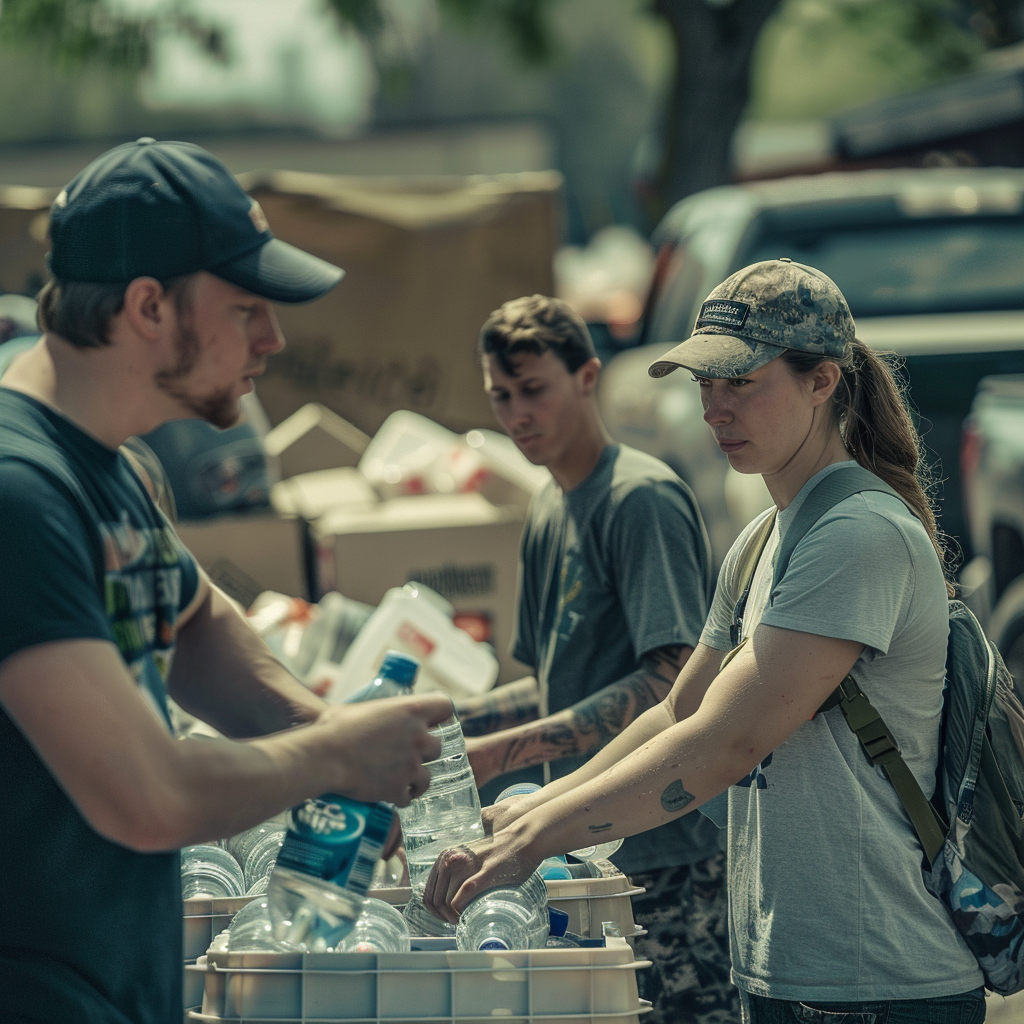
Neighborhood networks are another valuable aspect of community involvement. Establish connections with your neighbors and discuss how you can support each other during emergencies. Develop a neighborhood communication plan, share resources, and identify individuals with specific skills or equipment that could be useful in a crisis. By fostering a sense of community and collaboration, you can enhance overall preparedness and ensure a more coordinated response to emergencies.
Regular Updates and Reviews
Preparedness is not a one-time effort but an ongoing process that requires regular updates and reviews. Schedule periodic reviews of your plan to ensure it remains current and effective. This includes checking the expiration dates of food, water, and medical supplies, updating emergency contact lists, and revising your plan to account for any changes in your family’s needs or circumstances. Conducting regular reviews helps you identify gaps in your preparedness and make necessary adjustments.
Stay updated on new developments and best practices in the field of preparedness. Subscribe to newsletters from reputable preparedness organizations, follow experts on social media, and participate in webinars and training sessions. Keeping up with the latest information ensures that your preparedness plan incorporates the most effective strategies and tools available. Additionally, sharing what you learn with your family and community can help raise awareness and improve overall preparedness.
Practice makes perfect, so regularly conduct drills and exercises to test your preparedness plan. Simulate different emergency scenarios and practice your response, including evacuation routes, communication plans, and first aid procedures. These drills help reinforce the steps you need to take and build confidence in your ability to respond effectively. One of the best ways to test your plan is by turning your power off for the weekend. This gives you an opportunity to review your response efforts while maintaining a fallback safety net. If things go wrong, just turn the power back on and adjust your plan accordingly. By making regular updates, staying informed, and practicing your plan, you can maintain a high level of preparedness and be ready for any situation.
7. Maintaining and Updating Your Supplies
Regular Checks
Maintaining your preparedness supplies is an ongoing task that requires regular checks to ensure everything is in good working order. Schedule routine inspections of your food, water, medical supplies, and equipment. Make it a habit to check your supplies at least once every six months, but more frequently if possible. During these checks, look for signs of wear and tear, damage, or expiration. Items like batteries, medications, and food have specific shelf lives and need to be rotated or replaced to remain effective.
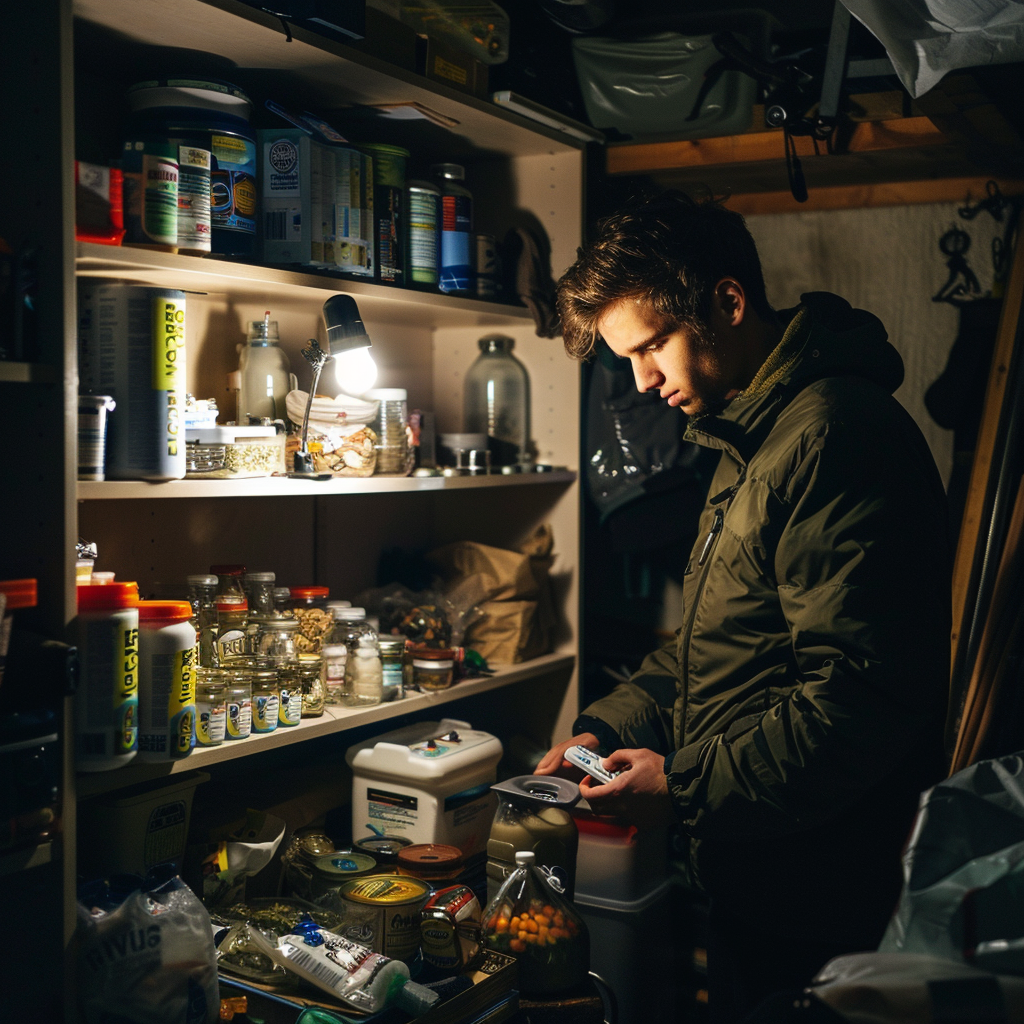
Create a checklist to guide your inspections, ensuring you don’t overlook any critical items. This checklist should include all the supplies in your emergency kits, bug-out bags, and home storage. Mark down the date of your last inspection and note any items that need replacement or replenishment. Keeping a detailed log can help you stay organized and ensure your supplies are always ready for use.
Don’t forget to inspect non-perishable items, such as tools and clothing. Ensure that your gear is in good condition and functioning properly. For example, test your flashlights, radios, and fire-starting tools to confirm they work correctly. Check your tents, sleeping bags, and other outdoor gear for any signs of damage. Regular checks help you maintain the integrity of your preparedness supplies, ensuring they will perform when you need them most.
Expiration Dates
Keeping track of expiration dates is crucial for maintaining the efficacy of your preparedness supplies. Food, water, and medications all have finite shelf lives, and using expired items can be dangerous. Begin by labeling all your supplies with their expiration dates as soon as you acquire them. Use a permanent marker to write the date on the packaging or use a label maker for a more organized appearance. This practice makes it easy to identify items that need to be rotated or replaced.
Set up a system to track these expiration dates, such as a spreadsheet or a dedicated notebook. Organize your list by categories, including food, water, medications, and first aid supplies. Update this list regularly as you conduct your routine checks. Consider using color-coded labels or stickers to quickly identify items that are nearing their expiration dates. For example, use red stickers for items that will expire within the next three months, yellow for six months, and green for one year or more.
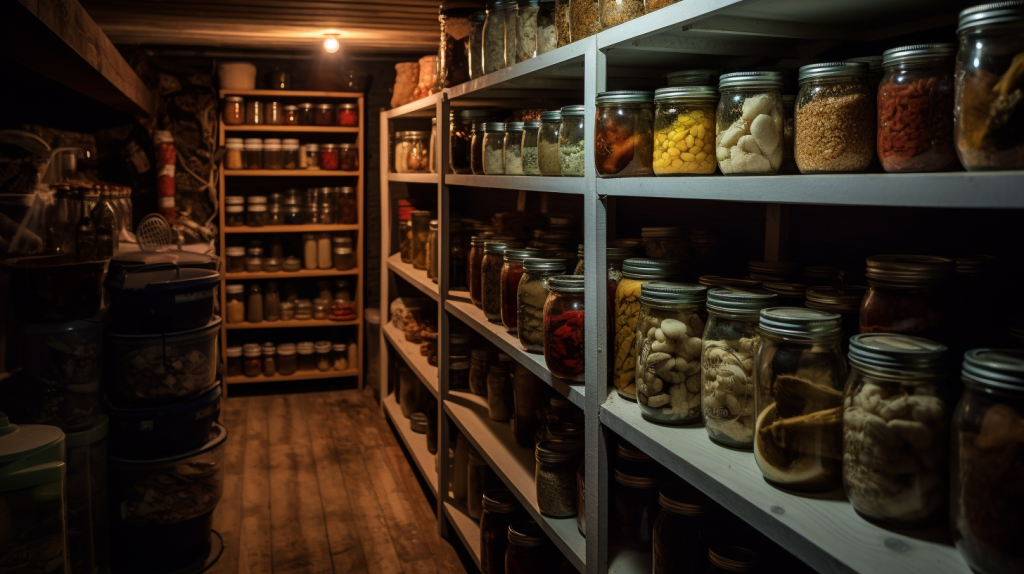
Develop a rotation system to ensure that older items are used first. When you add new supplies to your stockpile, place them at the back and move older items to the front. This “first in, first out” method helps you use items before they expire, reducing waste and ensuring that your supplies remain fresh. By diligently tracking and managing expiration dates, you can maintain a reliable stockpile that will be safe and effective during emergencies.
Seasonal Adjustments
Preparedness plans and supplies should be flexible and adaptable to seasonal changes. Different times of the year present unique challenges, and your supplies should reflect those variations. For example, winter may require additional cold-weather gear, such as blankets, thermal clothing, and hand warmers, while summer might necessitate extra hydration solutions, sun protection, and insect repellent. Assess the seasonal risks in your area and adjust your supplies accordingly.
In the spring and fall, conduct a thorough review of your preparedness supplies to make any necessary adjustments. Swap out seasonal items and update your emergency kits to reflect the changing conditions. For instance, replace heavy winter clothing with lighter, breathable options for the warmer months. Ensure your supplies include items like sunscreen and hats for summer, and add rain gear for spring and fall. Keeping your supplies seasonally appropriate ensures you are prepared for the specific challenges each season brings.
Seasonal adjustments also apply to your home’s emergency preparedness. For example, in winter, make sure your home is well-insulated, and you have a reliable source of heat. In summer, focus on cooling solutions and preventing heat-related illnesses. Additionally, certain natural disasters, like hurricanes or wildfires, are more common in specific seasons. Prepare accordingly by reinforcing your home, creating evacuation plans, and staying informed about potential threats. By making these seasonal adjustments, you enhance your preparedness and ensure you can handle any situation year-round.
Your Path to Preparedness: Taking the Next Steps

Preparedness is a journey, not a destination. By taking the steps outlined in this guide, you are proactively safeguarding your family’s well-being and ensuring you’re ready to face any challenge that comes your way. From understanding the basics of preparedness and assessing your unique needs to building essential supplies, developing a robust plan, and honing crucial skills, each step you take strengthens your resilience.
Remember, maintaining and updating your supplies regularly, staying informed, and adjusting your preparedness plan to reflect seasonal changes are all vital components of a comprehensive approach to preparedness. At Tomahawk Outpost, we’re committed to providing you with the high-quality gear and resources you need to succeed. Our shop offers a wide range of survival kits, emergency supplies, and tools designed to support your journey towards self-reliance.
To further assist you, we’ve created a handy 1-page Preparedness Quick-Start Guide that can be printed out and used as a quick reference. This guide touches on key points from this article and ensures you don’t miss any critical steps in your preparedness planning. Download it today and start building your path to security and peace of mind. Your journey to preparedness begins now, and we’re here to support you every step of the way.
